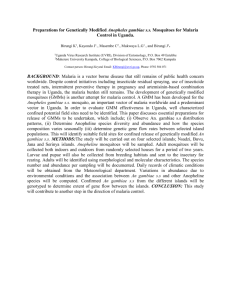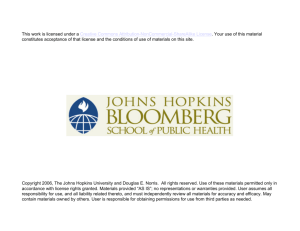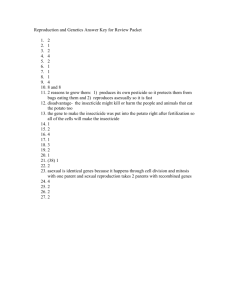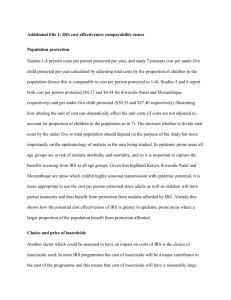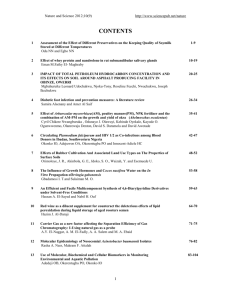Current Research Journal of Biological Sciences 5(2): 42-48, 2013
advertisement
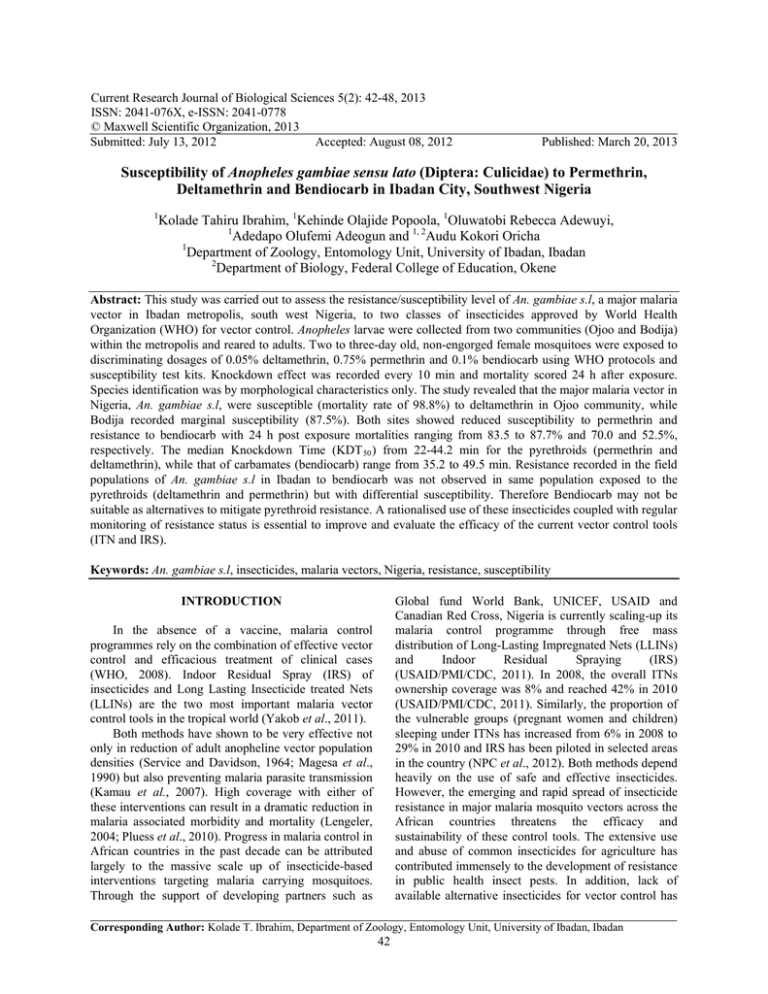
Current Research Journal of Biological Sciences 5(2): 42-48, 2013 ISSN: 2041-076X, e-ISSN: 2041-0778 © Maxwell Scientific Organization, 2013 Submitted: July 13, 2012 Accepted: August 08, 2012 Published: March 20, 2013 Susceptibility of Anopheles gambiae sensu lato (Diptera: Culicidae) to Permethrin, Deltamethrin and Bendiocarb in Ibadan City, Southwest Nigeria 1 Kolade Tahiru Ibrahim, 1Kehinde Olajide Popoola, 1Oluwatobi Rebecca Adewuyi, 1 Adedapo Olufemi Adeogun and 1, 2Audu Kokori Oricha 1 Department of Zoology, Entomology Unit, University of Ibadan, Ibadan 2 Department of Biology, Federal College of Education, Okene Abstract: This study was carried out to assess the resistance/susceptibility level of An. gambiae s.l, a major malaria vector in Ibadan metropolis, south west Nigeria, to two classes of insecticides approved by World Health Organization (WHO) for vector control. Anopheles larvae were collected from two communities (Ojoo and Bodija) within the metropolis and reared to adults. Two to three-day old, non-engorged female mosquitoes were exposed to discriminating dosages of 0.05% deltamethrin, 0.75% permethrin and 0.1% bendiocarb using WHO protocols and susceptibility test kits. Knockdown effect was recorded every 10 min and mortality scored 24 h after exposure. Species identification was by morphological characteristics only. The study revealed that the major malaria vector in Nigeria, An. gambiae s.l, were susceptible (mortality rate of 98.8%) to deltamethrin in Ojoo community, while Bodija recorded marginal susceptibility (87.5%). Both sites showed reduced susceptibility to permethrin and resistance to bendiocarb with 24 h post exposure mortalities ranging from 83.5 to 87.7% and 70.0 and 52.5%, respectively. The median Knockdown Time (KDT 50 ) from 22-44.2 min for the pyrethroids (permethrin and deltamethrin), while that of carbamates (bendiocarb) range from 35.2 to 49.5 min. Resistance recorded in the field populations of An. gambiae s.l in Ibadan to bendiocarb was not observed in same population exposed to the pyrethroids (deltamethrin and permethrin) but with differential susceptibility. Therefore Bendiocarb may not be suitable as alternatives to mitigate pyrethroid resistance. A rationalised use of these insecticides coupled with regular monitoring of resistance status is essential to improve and evaluate the efficacy of the current vector control tools (ITN and IRS). Keywords: An. gambiae s.l, insecticides, malaria vectors, Nigeria, resistance, susceptibility Global fund World Bank, UNICEF, USAID and Canadian Red Cross, Nigeria is currently scaling-up its malaria control programme through free mass distribution of Long-Lasting Impregnated Nets (LLINs) and Indoor Residual Spraying (IRS) (USAID/PMI/CDC, 2011). In 2008, the overall ITNs ownership coverage was 8% and reached 42% in 2010 (USAID/PMI/CDC, 2011). Similarly, the proportion of the vulnerable groups (pregnant women and children) sleeping under ITNs has increased from 6% in 2008 to 29% in 2010 and IRS has been piloted in selected areas in the country (NPC et al., 2012). Both methods depend heavily on the use of safe and effective insecticides. However, the emerging and rapid spread of insecticide resistance in major malaria mosquito vectors across the African countries threatens the efficacy and sustainability of these control tools. The extensive use and abuse of common insecticides for agriculture has contributed immensely to the development of resistance in public health insect pests. In addition, lack of available alternative insecticides for vector control has INTRODUCTION In the absence of a vaccine, malaria control programmes rely on the combination of effective vector control and efficacious treatment of clinical cases (WHO, 2008). Indoor Residual Spray (IRS) of insecticides and Long Lasting Insecticide treated Nets (LLINs) are the two most important malaria vector control tools in the tropical world (Yakob et al., 2011). Both methods have shown to be very effective not only in reduction of adult anopheline vector population densities (Service and Davidson, 1964; Magesa et al., 1990) but also preventing malaria parasite transmission (Kamau et al., 2007). High coverage with either of these interventions can result in a dramatic reduction in malaria associated morbidity and mortality (Lengeler, 2004; Pluess et al., 2010). Progress in malaria control in African countries in the past decade can be attributed largely to the massive scale up of insecticide-based interventions targeting malaria carrying mosquitoes. Through the support of developing partners such as Corresponding Author: Kolade T. Ibrahim, Department of Zoology, Entomology Unit, University of Ibadan, Ibadan 42 Curr. Res. J. Biol. Sci., 5(2): 42-48, 2013 also been an issue (Coleman et al., 2006). For example, the current control tools are highly dependent on a single class of insecticides, the pyrethroids. Out of the four classes of insecticides (organochlorine, pyrethroids and carbamates and organophosphates) approved for malaria vector control (Devine and Ogusuku, 2009) pyrethroids are the most compounds for IRS and the only insecticide class recommended for use in ITNs (WHO, 2010a). This is for safety, efficacy, acceptability and cost reasons (WHO, 2010b). Unfortunately, resistance to pyrethroids in An. gambiae s.l and An. funestus has emerged and it is spreading rapidly (Etang et al., 2003; Corbel et al., 2004). This has constituted an impediment to vector control initiatives in African countries (Hemingway et al., 2004; WHO, 2005). In Nigeria, the development of resistance to DDT and other classes of insecticides including organochlorine, organophosphate, carbamates and recently pyrethroid has been reported in Anopheles gambiae s.s. An. arabiensis and An. funestus from different zones (Awolola et al., 2005, 2007). In southwest Nigeria, the first case of pyrethroid resistance in Anopheles gambiae, the major malaria vector, in Nigeria was documented (Awolola et al., 2002) and since then the phenomenon has been well established in this region (Awolola et al., 2003; Kristan et al., 2003; Awolola et al., 2005, 2007; Oduola et al., 2010, 2012). Also in North-central Nigeria, Permethrin and DDT resistance in An. gambiae s.l has been reported (Ndams et al., 2006; Olayemi et al., 2011). In light of ongoing scaling-up of control tools (LLINs and IRS) with the goal to reduce by 50% the malaria related morbidity and mortality in Nigeria by 2013 (USAID/PMI/CDC, 2011). It is therefore crucial that information on the susceptibility of major malaria vectors to common insecticide used in public health and the underlying mechanism are investigated nationwide. This will properly informed control programs of the most suitable insecticide to use and facilitate the design of appropriate resistance management strategies (Djouaka et al., 2011). Furthermore, there is a need to look into alternatives to pyrethroid insecticides to manage resistance. Reports from the neighboring country, Republic of Benin has identified carbamates bendiocarb as a potential alternative to combat pyrethroid-DDT resistance in An. gambiae populations (Corbel et al., 2007; Akogbeto et al., 2010), mainly because of its separate mode of action (Oduola et al., 2012). However, there is dearth of information on the insecticide resistance status of the field strain of An. gambiae in Nigeria to carbamate insecticide (Olayemi et al., 2011; Oduola et al., 2012). In this study, we investigated susceptibility status of An. gambiae s.l population in Ibadan city Southwest Nigeria to pyrethroids (permethrin and deltamethrin) and alternative insectide, carbamate (bendiocarb). MATERIALS AND METHODS Study area: This study was conducted in Ibadan. Ibadan (07°22ˈN, 03°58ˈE) is the capital city of Oyo state in south western Nigeria. It is belongs to transitional forest-savannah climatic domain with average temperature ranges from 25 to 38°C and mean annual rainfall is 131.42 cm. The city has an estimated population of 3.57 million people on an estimated land area of 3080 km2 (Fig. 1). Mosquito larval collection and rearing: Immature stages of anopheles mosquitoes were collected from two sites, Bodija and Ojoo, within Ibadan metropolis during the rainy season July to September 2011. At each locality chosen, Anopheline larvae were collected from various natural breeding sites including ground pools, gutters, tire tracks and puddles. Water was scooped using a plastic scoop and poured into small transparent plastic bowls. A strainer was used to sieve and pool together the third and fourth instars larvae in order to have sufficient adult emergence of the same physiological age. The bowls were scrutinized for presence of unwanted organisms or predators; if any were found, a pipette was used to remove them. The Global Positioning System (GPS) was used to establish the coordinates of the study sites. The mosquito larvae collected were transported in well labeled plastic bottles to the insectary in the Entomology unit of the Department of zoology, University of Ibadan, where they were maintained at 26±3C and 74±4% relative humidity. The resulting adults were identified as An. gambiae s.l according to the morphological keys (Gillies and Coetzee, 1987). Female adult mosquitoes belonging to the Anopheles gambiae complex were blood-fed and placed in breeding tubes, three days postfeeding to lay eggs. Emerging adult females (F1 generation) were fed on sugar 10% solution and used in the bioassays. Insecticide susceptibility tests: Insecticide susceptibility tests were carried out using the WHO standard procedures and test kits for adult mosquitoes (WHO, 1998). Three types of WHO bioassay test papers impregnated with recommended diagnostic concentrations of 0.05% deltamethrin, 0.75% permethrin and 0.1% bendiocarb were used. The Kisumu reference strain susceptible to all insecticide classes was used to establish the potency of the treated papers before the exposures were carried out using wild samples. Tests were carried out using 2-3 day old, sugar-fed female mosquitoes. For each insecticide, four replicates of 20 female mosquitoes were exposed by tarsal contact to insecticide-impregnated test papers in the test tubes for 1 h. Controls included batches of mosquitoes from each site exposed to untreated papers. The knockdown effect of each insecticide was recorded 43 Curr. Res. J. Biol. Sci., 5(2): 42-48, 2013 3°51' 3°53' 3°55' 3°57' 7°29' 7°29' IITA OJOO N NISSER ODOGBO BARRACK OROGUN 7°27' 7°27' APETE AGBOWO AWOTAN AKOBO UNIVERSITY OF IBADAN BODIJA MKT TRANS AMUSEMENT PARK THE POLYTHECNIC IBADAN IJOKODO SANGO BODIJA ESTATE CATHMENT AREA OLOGUNERU KONGI SAMONDA NEW OLUWO AKOBO HOUSING ESTATE OLD BODIJA ARMY BARRACK MOKOLA BASORUN OREMEJI STATE SECRETARIAT PREMIER HOTEL B.C.O.S AGODI GRA UCH JERICHO ABAYOMI ADAMASINGBA STADIUM EKOTEDO ALESHILOYE MKT. DUGBE 7°23' IDIKAN LGO OKE ADO LIBERTY STADIUM ORELOPE GBAREMU OLODA MAPO HALLAREMO CHURCH MAPO OJAGBO ISALE IJEBU APERIN ELEKURO IDI ARERE BABANLA ODINJO Legend BODE OLUYOLE ESTATE R. O NA 7°21' NEW ADEOYO ELEWURA CHALLENGE OLRUNSOGO OWODE FELELE STATE HOSPITAL ORITA KEREKU Road Stream River MOLETE IMALE FALAFIA BOLA IGE MKT. AREMO BERE IYANGANKU GRA MOTALA AGUGU YEOSA OKE ARE OKEBOLA D`ROVANS HOTEL ALAPERE AGODI GATE YEMETU OKE AREMO OJE BOWER TOWER JERICHO MOOR APATA GANGA PLANTATION ODO-ONA NTA 7°23' ONIREKE IDI ISHIN OLUYOLE IKOLABA IDI APE ILETITUN 7°21' NIHORT FARM 7°25' 7°25' KAJOLA OKE TUNU ELEYELE Study Area ODO OBA OLOMI Railway ODO- ONA ELEWE Scale: LAGELU ESTATE 0 3.8 7.6 11.4 R .O G U N PA NEW GARAGE 3°51' S 3°53' i i f d d 3°55' 3°57' i Fig. 1: Map of Ibadan metropolis showing the larval collection sites every 10 min over the 1 h exposure period. After the exposure, mosquitoes were then transferred to a recovery tube and provided with 10% honey solution. Final mortalities were recorded 24 h post-exposure and the susceptibility status of the population was graded according to WHO recommended protocol (WHO, 1986). Dead and survived mosquitoes from this bioassay were separately kept in clearly labeled 1.5 mL tubes containing silica gel, for species identification. All susceptibility tests were carried out at 25±3°C temperature and 75±6% relative humidity. RESULTS Mortality: Overall, 1,335 adult mosquitoes were reared from larvae collected from two localities (Ojoo and Bodija) within Ibadan city. Of these, 600 female adult were morphologically identified as An. gambie s.l and exposed to diagnostic doses of three insecticides; permethrin (0.75%), deltamethrin (0.05%) and bendiocarb (0.1%). The mortality and knock down rates and resistance status of field populations of An. gambiae s.l against the insecticides were shown in Table 1. The mosquito populations from the both Ojoo and Bodija were resistance to 0.1% bendiocarb with 24 h post exposure mortalities of 70.0 and 52.5% respectively. However, they showed reduced susceptibility to 0.75% permethrin with 24 h post exposure mortalities ranging from 83.5 to 87.7% indicating suspected resistance that needs investigation. Susceptibility to 0.05% deltamethrin was found among mosquito populations in Ojoo community with mortality rate of 98.5%. Mosquito species from Bodija were less susceptible with mortality rate of 87.5%. Difference in mosquito mortality rates between the two Data interpretation and analysis: The resistant status of mosquito samples was determined according to WHO criteria (WHO, 1986a). Mortality rates of less than 80% indicate resistance while those greater than 98% indicate full susceptibility. Mortality rates between 80-98% suggest the possibility of resistance that needs to be clarified. Mortality rates were corrected using Abbott formula when control mortality was above 5% (Abott, 1987). The Student t test in SPSS version 15.0 was used to compare the KDT 50 and KDT 95 between the insecticides. 44 Curr. Res. J. Biol. Sci., 5(2): 42-48, 2013 Table 1: Knockdown times and percentage mortality (with 95% confidence intervals) of Anopheles gambiae 60 min KDT 50 KDT 95 (min) 95% CI (min) 95% CI Locality Insecticides N Ojoo Permethrin (0.75%) 80 34.00 (16.4-21.6) 64.60 (61.3-64.6) Deltamethrin (0.05%) 80 44.20 (41.1-47.7) 117.30 (92.6-157.4) Bendiocarb (0.1%) 80 49.50 (44.7-51.8) 85.41 (64.5-122.7) Bodija Permethrin (0.75%) 80 22.50 (17.1-31.9) 42.81 (38.9-46.7) Deltamethrin (0.05%) 80 27.70 (25.2-30.6) 61.91 (56.9-74.1) Bendiocarb (0.1%) 80 35.20 (26.5-42.3) 70.32 (67.4-82.9) CI: Confidence intervals s.l mosquitoes exposed to dosages of insecticides for Knockdown after 1 h exposure (%) 85.02 98.75 71.25 56.25 92.50 70.00 Mortality (%) after 24 h 87.65 98.53 70.03 83.52 87.52 52.51 Susceptibility status Suspected Full susceptible Resistance Suspected Suspected Resistance Table 2: Progressive mean number of knockdown and mean total mortality rates of anophelines population from Ojoo and Bodija communities in Ibadan metropolis, during exposure to insecticides Mean number of Knockdown (KD) mosquitoes Mean ------------------------------------------------------------------------------------------------------------------------------------mortality Sites Insecticides (conc) 0 min 10 min 20 min 30 min 40 min 50 min 60 min @ 24 h Ojoo Control (0.0%) 0.00 0.00 0.00 0.00 0.00 0.00 0.00 9.00±7.94 Bendiocarb (0.1%) 2.25±0.96 4.25±2.50 5.50±1.92 8.75±3.40 10.25±3.59 11.25±2.87 14.25±0.96 14.00±1.83 Deltamethrin (0.05%) 9.00±3.16 13.50±1.73 15.25±0.96 18.25±2.22 19.50±0.58 19.50±0.58 19.75±0.50 19.75±0.50 Permethrin (0.75%) 4.00±2.80 5.75±1.71 7.25±2.63 13.25±2.87 15.25±2.22 17.00±2.16 19.75±0.50 18.00±1.41 Bodija Control (0.0%) 0.00 0.00 0.00 0.00 0.00 0.00 0.00 3.33±3.51 Bendiocarb (0.1%) 2.25±1.50 2.75±1.26 3.75±1.50 5.75±0.96 8.75±3.78 9.50±2.38 14.00±1.83 10.50±2.65 Deltamethrin (0.05%) 5.50±1.73 5.75±1.50 10.50±1.29 12.00±1.82 14.75±1.26 18.00±1.41 18.50±0.58 17.50±1.29 Permethrin (0.75%) 2.50±1.29 1.75±0.96 1.75±1.50 6.00±0.82 7.00±0.82 11.00±1.83 11.25±1.71 17.00±1.83 CI: Confidence intervals communities for each insecticide treatments was not significant (p>0.05), using t-test. significantly higher (p<0.05) than other two insecticides throughout the exposure time. At Ojoo and Bodija survivors were found, >90% of An. gambiae s.l exposed to deltamethrin but <75% of those exposed to bendiocarb were knock-down during the 1 h exposure. The knock-down owing to 1 h exposure to permethrin was 85 and 56.25% in Ojoo and Bodija respectively. The corresponding mortalities at each of these sites, recorded 24 h after exposure, were also higher for deltamethrin than for other two insecticides (Table 1). Knock down: The median Knockdown Time (KDT 50 ) obtained from time-mortality regression using probit analysis range from 22.5 to 44.2 min, while the KDT 95 ranged from 42.8 to 117.3 min for the pyrethroids (permethrin and deltamethrin). The knock-down effect of deltamethrin was more pronounced than that of permethrin (Table 2) for the carbamates bendiocarb, the KDT 50 and KDT 95 ranges from 35.2 to 49.5 min and 70.3 to 85.4 min, respectively. The longest median Knockdown Time (KDT 50 ) of 49.5 min was observed in Ojoo mosquito population exposed to 0.1% bendiocarb, while the shortest knockdown of 22 min was recorded in Bodija mosquito population exposed to 0.75% deltamethrin. None of the three insecticides recorded a complete knock down within 60 min exposure. Considerably it took a long time for mosquitoes to be knockdown by bendiocab compared to other two insecticides. Table 2 shows the mean total number of adult female An. gambiae s.l knocked down at 10 min interval during an hour exposure to three insecticides and the mean total mortality rates recorded after 24 h recovery exposure. In both sites, all the three insecticides showed gradual knockdown abilities at various times during the 1 h exposure. Only deltamethrin was able to knockdown over 60% of the mosquito population within 30 min of exposure, while appreciable knockdown owing to permethrin and bendiocarb occurred at the latter times (40-60 min). While the significant (>50%) knockdowns due to deltamethrin exposure were restricted to last 30 min, that of bendiocarb were limited to last 20 min in both Ojoo and Bodija communities. All the insecticides tested show prolong knockdown activities but the knockdowns owing to deltamethrin was time after time DISCUSSION The resistance/susceptibility status of Anopheles gambiae sensu lato mosquitoes to 0.75% permethrin, 0.05% deltamethrin and 0.1% bendiocarb was investigated in Ibadan city, southwest Nigeria. Based on the conventional criteria for characterizing insecticide resistance/susceptibility, where susceptibility is defined by mortality rates greater than 98% 24 h post exposure, there was evidence of resistance among the mosquitoes tested from the two study sites (Ojoo and Bodija) in the city to bendiocarb and marginal resistance to permethrin. While the Ojoo mosquito populations were susceptible to deltermethrin, the Bodija collections recorded partial susceptibility indicating suspected resistance that needs investigation. The level of permethrin resistance (12.5%) in An. gambiae populations at the present study sites was much lower than the previous resistance levels of 72.279.6% previously reported by Awolola et al. (2003) in Alakia, a locality which is less than 10 km from the study sites. This signifies the focal nature of insecticide resistance which is not unusual at relatively short distances (Ranson et al., 2009). These different levels of insecticide susceptibility may reflect differential insecticide selection pressure exerted on field mosquito populations (Kerah-Hinzoumbé et al., 2008). 45 Curr. Res. J. Biol. Sci., 5(2): 42-48, 2013 owing to exposure to deltamethrin compared to permethrin observed in this study is consistent with those other studies conducted in Nigeria (Awolola et al., 2002, 2003) and Ghana (Adasi and Hemingway, 2008). This is probably due to the fact that permethrin has been used much longer for agricultural and public health purposes than deltamethrin (Adasi and Hemingway, 2008). Also deltamethrin belong to the subgroup of pyrethroids containing an alpha cyanogroup in their chemical structure and are extremely potent against insects even at much lower concentration (WHOPES, 2005). In this study, the lowest level of mortality <75% (the highest frequency of resistance) was recorded from An. gambiae s.l populations exposed to 0.1% bendiocarb. Resistance of bendiocarb appear to be widespread throught the study area. This study shows another report of carbamate resistance in An. gambiae s.l populations in southwest Nigeria and evidence of its occurrence in populations already harbouring resistance to pyrethroids. This result agrees with previous study which reported high resistance of An. gambiae populations to carbamate (Oduola et al., 2012). The bendiocarb resistance recorded in this study raises a special concern for National Malaria Control programs which, because of high resistance to pyrethroids and DDT, are currently introducing bendiocarb based IRS for malaria vector control in West African countries (Djouaka et al., 2011). Therefore in the search of National malaria control programs for a suitable replacement to pyrethroid for IRS as part of an insecticide management strategy, cabamates may not be the right candidate for malaria control in South west Nigeria. Alakia is a rural community in Ibadan with substantial agricultural use of insecticides (Awolola et al., 2002). Also the high resistance observed may probably be due to the extensive use of DDT and pyrethroids for crop protection (Chandre et al., 1999). The use insecticides for malaria control and of pesticides in agriculture is however by and large low in Ojoo and Bodija. The marginal pyrethroid resistance might have resulted from selection pressure exerted on the An. gambiae populations by the extensive use of pyrethroid based aerosol and coils for domestic pest and vector control (Kristan et al., 2003). Furthermore, selection pressure due to increased LLINs coverage or spreading of the resistant mosquito population is other possible causes in urban cities (Kabula et al., 2011). Nevertheless, the relatively low frequencies of resistance found in the present study should not hinder the promotion and the use of LLINs for protection against malaria transmission in this part of southwest Nigeria. The incidence of urban mosquito populations resistant to multiple classes of insecticides used in public health witnessed in this study is not new, as Oduola et al. (2010, 2012) reported similar occurrence in Anopheles gambiae populations in Lagos city, Nigeria. Similar observations were reported in An. gambiae populations in Guinea Conakry (Vezenegho et al., 2009) and Congo (Koekemoer et al., 2011). The detection of multiple resistances in major vectors of malaria in Nigeria may have grave implications for the malaria control programme. It may compromise the efficacy of interventions and potentially lead to the failure of IRS and ITNs based vector control. While this data serves to highlight the threats more information is required on all the underlying mechanisms of insecticide resistance so that a suitable insecticide resistance management plan may be put in place to sustain vector control. The marginal resistance and resistance recorded in An. gambiae s.l populations from the two study sites, to the three insecticides tested is characterized by high KDT 50 that ranges from 34.0-49.5 min and 22.5-35.2 min in Ojoo and Bodija communities, respectively. Comparable high KDT 50 was recorded in the sites with full susceptibility to deltamethrin. The result from this study is consistent with the higher KDT 50 found in urban An. gambiae populations exposed to these insecticides in Lagos, southwest Nigeria (Oduola et al., 2012). Higher KDT 50 values in the field population have been suggested to give an early indication of the involvement of kdr mechanism of resistance (Chandre et al., 1999). This may be consistent with saudy carried out in southwest Nigeria by Kristan et al. (2003) who reported absence or low frequency of kdr in An. gambiae s.l. This calls for further investigation to be carried out to determine the presence of kdr alleles in our mosquito population. At comparable toxicities, deltamethrin was more efficacious than the permethrin. The higher mortality CONCLUSION Pyrethroid resistance may seriously jeopardize the efficacy of IRS and LLINs on which most African countries including Nigeria, rely to reduce malaria transmission. This study reveals the presence of carbamates bendiocarb resistance and reduced susceptibility/marginal resistance to pyrethroids in An. gambiae s.l populations the major malaria vector in Nigeria. The current findings will help for decisionmaking in the National Malaria control programme particularly in the choice of insecticide to use during campaigns of Indoor residual spraying in south west Nigeria. This suggests multiple suitable alternative insecticides beside carbamates to substitute for the pyrethroid resistance in An. gambiae populations in Ibadan metropolis. In view of the limited numbers of insecticides available for vector control, a rational use of insecticides or mosaic strategy can be adopted to delay development of resistance in malaria vectors in Nigeria. Therefore routine surveillance of insecticide susceptibility/resistance in wild anopheline populations across different ecological zones in Nigeria is very critical for effective resistance management strategy. 46 Curr. Res. J. Biol. Sci., 5(2): 42-48, 2013 Author’s contributions: KTI conceived and designed the study, supervised field and laboratory procedures, data analysis and interpretation and drafting of manuscript. KOP was involved in the study design, supervised laboratory procedures and reviewed the draft manuscript. ORA, AOA and AKO participated in field and laboratory studies and the analysis of data. All authors read and approved the final version of the manuscript. Coleman, M., S. Brian, I. Seocharan and J. Hemingway, 2006. Developing evidence- based decision support system for rational insecticide choice in the control of African malaria vectors. J. Med. Entomol., 43(4): 663-668. Corbel, V., F. Chandre, C. Brengues, M. Akogbeto, F. Lardeux, J.M. Hougard and P. Guillet, 2004. Dosage-dependent effects of permethrin-treated nets on the behaviour of Anopheles gambiae and the selection of pyrethroid resistance. Malar. J., 3: 22. Corbel, V., R. N’Guessan, C. Brengues, F. Chandre, L. Djogbenou, T. Martin, M. Akogbeto, J.M. Hougard and M. Rowland, 2007. Multiple insecticide resistance mechanisms in Anopheles gambiae and Culex quinquefasciatus from Benin, West Africa. Acta Trop., 101: 207-216. Devine, G.J. and E. Ogusuku, 2009. Adaptability is key when monitoring insecticide resistance. Bull. World Health Organ., 87: 887-887. Djouaka, R., H. Irving, Z. Tukur and C.S. Wondji, 2011. Exploring mechanisms of multiple insecticide resistance in a population of the malaria vector Anopheles funestus in Benin. PLoS ONE, 6(11): e27760, Doi: 10.1371/journal.pone. 0027760. Etang, J., L. Manga, F. Chandre, P. Guillet, E. Fondjo, R. Mimpfoundi, J.C. Toto and D. Fontenille, 2003. Insecticide susceptibility status of anopheles gambiae s.l. (Diptera: Culicidae) in the republic of cameroon. J. Med. Entomol., 40: 491-497. Gillies, M.T. and M. Coetzee, 1987. A supplement to the anophelinae of Africa south of the sahara. Pub. South African Inst. Med. Res., 55: 1-143. Hemingway, J., N.J. Hawkes, L. McCarroll and H. Ranson, 2004. The molecular basis of insecticide resistance in mosquitoes. Insect Biochem. Molecu. Biol., 34: 653-665. Kabula, B., Y.A. Derua, P. Tungu, D.J. Massue, E. Sambu, G. Stanley, F.W. Mosha and W.N. Kisinza, 2011. Malaria entomological profile in Tanzania from 1950 to 2010: A review of mosquito distribution, vectorial capacity and insecticide resistance. Tanz. J. Health Res., 13(1). Kamau, L., D. Agai, D. Matoke, L. Wachira, G. Gikandi and J.M. Vulule, 2007. Status of insecticide susceptibility in Anopheles gambiae sensu lato and Anopheles funestus mosquitoes from Western Kenya. J. Insect Sci., 8(11): 1-7. Kerah-Hinzoumbé, C., M. Péka, P. Nwane, I. DonanGouni, J. Etang, A. Samè-Ekobo and F. Simard, 2008. Insecticide resistance in Anopheles gambiae from south-western Chad, Central Africa. Malar. J., 7: 192. ACKNOWLEDGMENT We sincerely thank Dr Samson Awolola, Head of public health Division of Nigeria Institute of Medical Research (NIMR) Lagos, for providing the test kits and insecticide treated papers for the bioassay. REFERENCES Abott, W.S., 1987. A method of computing the effectiveness of an insecticide. J. Am. Mosq. Cont. Assoc., 3: 302-303. Adasi, K. and J. Hemingway, 2008. Susceptibility to three pyrethroids and detection of knockdown resistance mutation in Ghanaian Anopheles gambiae sensu stricto. J. Vect. Ecol., 33: 255-262. Akogbeto, M.C., G.G. Padonou, D. Gbenou, S. Irish and A. Yadouleton, 2010. Bendiocarb, a potential alternative against pyrethroid resistant Anopheles gambiae in Benin, West Africa. Malar. J., 9: 204. Awolola, T., A. Oduola, I.O. Oyewole, J.B. Obansa, C. Amajoh, L. Koekemoer and M. Coetzee, 2007. Dynamics of knockdown pyrethroid insecticide resistance alleles in a field population of Anopheles gambiae s.s. in southwestern Nigeria. J. Vect. Born. Disease, 44: 181-188. Awolola, T.S., B.D. Brooke, R.H. Hunt and M. Coetzee, 2002. Resistance of the malaria vector Anopheles gambiae s.s to pyrethroid insecticide in south western-Nigeria. Ann. Trop. Med. Parasitol., 96: 849-852. Awolola, T.S., B.D. Brooke, L.L. Koekemoer and M. Coetzee, 2003. Absence of the kdr mutation in the molecular 'M' form suggests different pyrethroid resistance mechanisms in the malaria vector mosquito Anopheles gambiae s.s. Trop. Med. Int. Health, 8: 420-422. Awolola, T.S., I.O. Oyewole, C.N. Amajoh, E.T. Idowu, M.B. Ajayi, A. Oduola, O.U. Manafa, K. Ibrahim, L.L. Koekemoer and M. Coetzee, 2005. Distribution of the molecular forms of Anopheles gambiae and pyrethroid knock down resistance gene in Nigeria. Acta Trop., 95: 204-209. Chandre, F., F. Darriet, S. Manguin, C. Brengues, P. Carnevale and P. Guillet, 1999. Pyrethroid cross-resistance spectrum among populations of Anopheles gambiae s.s. from Cote D’Ivoire. J. Am. Mosq. Cont. Assoc., 15: 53-59. 47 Curr. Res. J. Biol. Sci., 5(2): 42-48, 2013 Koekemoer, L.L., B.L. Spillings, R.N. Christian, T.M. Lo, M.T. Kaiser, R.A.I. Norton, S.V. Oliver, K.S. Choi, B.D. Brooke, R.H. Hunt and M. Coetzee, 2011. Multiple insecticide resistance in Anopheles gambiae (Diptera: Culicidae) from pointe noire, republic of the Congo. Vect. Borne Zoonot. Dis., 1, Doi: 10.1089/. Kristan, M., H. Fleischman, A. Della Torre, A. Stich and C.F. Curtis, 2003. Pyrethroid resistance/ susceptibility and differential urban/rural distribution of Anopheles arabiensis and An. gambiae s.s malaria vectors in Nigeria and Ghana. Med. Vet. Entomol., 17: 326-332. Lengeler, C., 2004. Insecticide-treated bed nets and curtains for preventing malaria. Cochrane Db. Syst. Rev., 2: CD00036. Magesa, S.M., J. Wilkest, A.E.P. Minzawa, J. Myamba and M.D. Philip, 1990. Trial of pyrethroid impregnated bed nets in area of Tanzania holoendemic of malaria. Part II: Effects on vector population. Acta Trop., 49: 97-108. Ndams, I.S., K.M. Laila and Z. Tukur, 2006. Susceptibility of some species of mosquitoes to permethrin pyrethroids in Zaria, Nigeria. Sci. World J., 1(1): 15-19. NPC (National Population Commission) [Nigeria], National Malaria Control Programme (NMCP) [Nigeria] and ICF International (2012). Nigeria Malaria Indicator Survey 2010. Abuja, Nigeria: NPC, NMCP and ICF International Oduola, A.O., J.B. Obansa, C.O. Ashiegbu, O.A. Otubanjo and T.S. Awolola, 2010. High level of DDT resistance in the malaria mosquito: Anopheles gambiae s.l. from rural, semi urban and urban communities in Nigeria. J. Rural Trop. Pub. Health, 9: 114-120. Oduola, A.O., E.T. Idowu, M.K. Oyebola, A. Adeogun, J.B. Olojede, O.A. Otubanjo and T.S. Awolola, 2012. Evidence of carbamate resistance in urban populations of Anopheles gambiae s.s. mosquitoes resistant to DDT and deltamethrin insecticides in Lagos, South-Western Nigeria. Paras. Vect., 5: 116. Olayemi, I.K., A.T. Ande, S. Chitta, G. Ibemesi, V.A. Ayanwale and O.M. Odeyemi, 2011. Insecticide susceptibility profile of the principal malaria vector, Anopheles gambiae s.l (Diptera: Culicidae). J. Vect. Borne Dis., 48: 109-112. Pluess, B., F.C. Tanser, C. Lengeler and B.L. Sharp, 2010. Indoor residual spraying for preventing malaria. Cochrane Db. Syst. Rev., 4: CD00 6657. (Doi: 10.1002/14651858. CD006657.pub2). Ranson, H., H. Abdallah, A. Badolo, W.M. Guelbeogo, C. Kerah-Hinzoumbe, E. Yangalbé-Kalnoné, N.F. Sagnon, F. Simard and M. Coetzee, 2009. Insecticide resistance in Anopheles gambiae: Data from the first year of a multi-country study highlight the extent of the problem. Malar. J., 8: 299. Service, M.V. and G. Davidson, 1964. A light incident of dieldrin resistance in An. gambiae Giles from an unsprayed area in northern Nigeria. Nature, 203: 209-210. USAID/PMI/CDC, 2011. Nigeria FY 2012 Malaria Operational Plan. pp: 46. Retrieved from: pmi.gov/countries/mops/fy12/nigeria_mop_fy12.p df. Vezenegho, S.B., B.D. Brooke, R.H. Hunt, M. Coetzee and L.L. Koekemoer, 2009. Malaria vector mosquito composition and insecticide susceptibility status in Guinea Conakry, West Africa. Med. Vet. Entomol., 23: 326-334. WHO, 1986a. Organophosphorus insecticides: A general introduction. Env. Health Criteria, 63: 1-112. WHO, 1998. Test procedures for insecticide resistance monitoring in malaria vectors, bio-efficacy and persistence of insecticides in treated surfaces. Report of the WHO Informal Consultation. WHO/CDS/CPC/MAL/98.12. World Health Organization, Geneva, Switzerland. WHO, 2005. Guidelines for laboratory and field testing of long-lasting insecticidal mosquito nets. Report, WHO/HQ, World Health Organization, Geneva. WHO, 2008. The Global Malaria Action Plan for a Malaria Free World. Roll Back Malaria Partnership, Geneva, Switzerland. WHO, 2010a. WHO Global Malaria Programme, Retrieved from: http: //whqlibdoc. who.int/ publications/2010/9789241564106_eng. pdf via internet, (Accessed on: December 10, 2011). WHO, 2010b. World malaria report 2010. World Health Organisation, Geneva. WHOPES, 2005. Safety of Pyrethroids for Public Health Use. WHO Pesticide Evaluation Scheme. Yakob, L., G. Yan and R. Dunning, 2011. Indoor residual spray and insecticide-treated bednets for malaria control: Theoretical synergisms and antagonisms. J. R. Soc. Interface, 8(59): 799-806, DOI: 10.1098/rsif.2010.0537. 48
